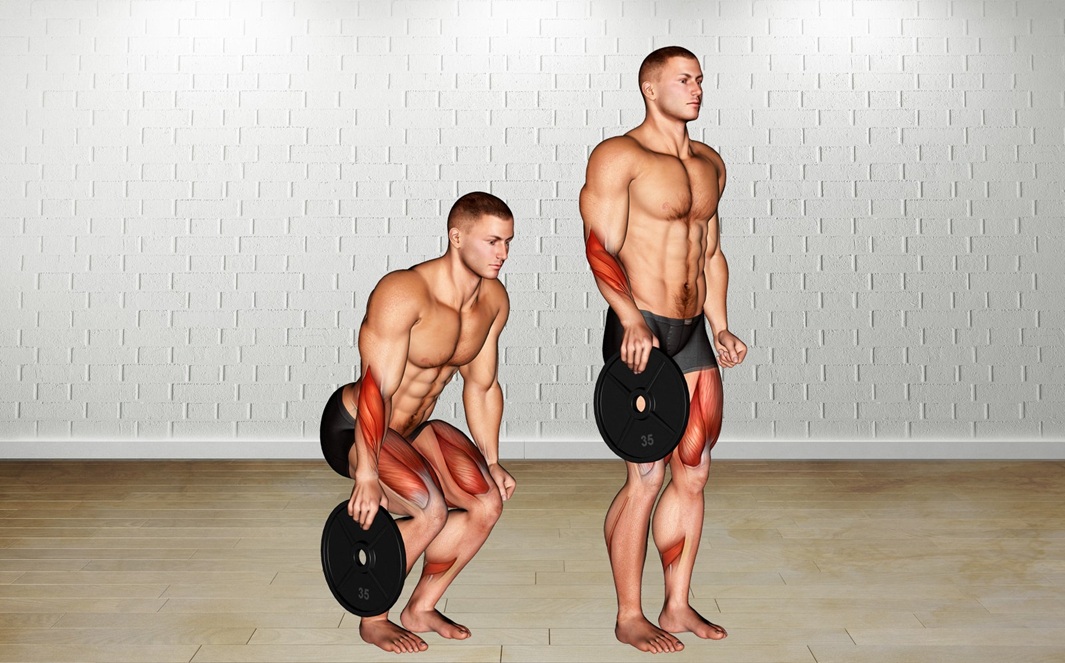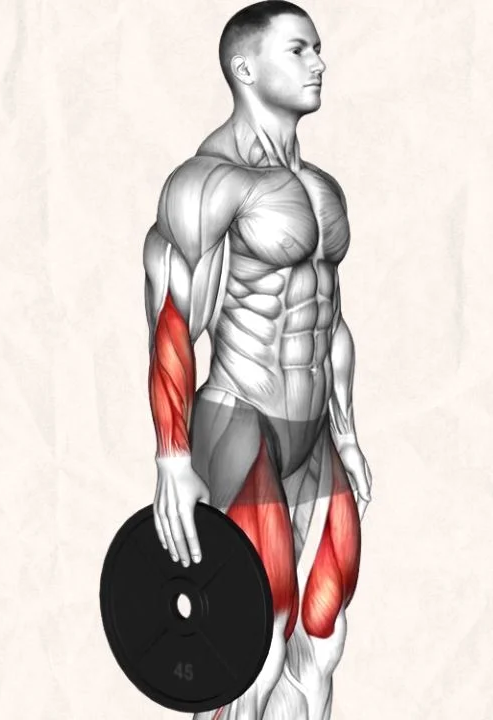Plate Pinch Hold (Grip & Finger Strength Builder): The Forgotten Secret to Forearm Power
If you’ve ever admired the thick, veiny forearms of elite lifters or strongmen, chances are they’ve spent plenty of time doing plate pinches. The Plate Pinch Hold is one of the simplest yet most brutal grip and forearm builders out there — no machines, cables, or fancy setups required.
You just grab two smooth weight plates, press them together, and hold. That’s it. But the tension on your forearms, fingers, and thumb is unlike anything else.
This lift isolates crushing grip, pinching power, and finger strength — the kind of attributes that separate casual gym-goers from seasoned bodybuilders and strength athletes.
From a bodybuilder’s point of view, the Plate Pinch Hold is an underrated tool for forearm density, vascularity, and overall grip endurance.
It builds the kind of muscle detail that makes the difference between “good” arms and elite, competition-ready forearms that complete your physique.
Muscles Worked
Primary Muscles:
- Forearm Flexors (Flexor Digitorum Profundus & Superficialis) – responsible for curling the fingers and gripping the plates tightly.
- Thenar & Hypothenar Muscles (Thumb Pads) – stabilize the thumb during the pinch.
- Brachioradialis – supports forearm flexion and grip stability.
Secondary Muscles:
- Extensor Muscles of the Forearm – counterbalance the grip and prevent wrist collapse.
- Wrist Stabilizers & Finger Extensors – help maintain neutral alignment and endurance.
- Shoulders and Traps – engaged isometrically to stabilize the plates.
💡 In short: The Plate Pinch Hold trains static grip endurance, thumb strength, and forearm size in one movement.
Why Every Lifter Should Train Pinch Grip
Unlike most gym lifts that rely on wrapping your hand around a bar, the Plate Pinch Hold challenges your hand to squeeze flat surfaces together — using your fingers and thumb like a vise.
This movement pattern develops a type of grip strength that directly improves performance in:
- Deadlifts (bar control and hold at lockout)
- Pull-ups and rows (grip endurance)
- Arm wrestling and functional strength sports
- Everyday carry and manual work
But for bodybuilders specifically, the Plate Pinch Hold does something unique:
It rounds out forearm development, building muscles in your hands and wrists that no curl or roller can reach. The result? Fuller, more symmetrical forearms with detailed separation and vascularity.
How to Perform the Plate Pinch Hold
Setup
- Select Your Plates
- Start with two smooth plates (metal preferred for grip challenge).
- Place them together, smooth sides out, so the friction is minimal.
- Grip the Plates
- Stand upright with plates at your side.
- Squeeze them between your fingers and thumb — no wrapping your fingers around edges.
- Keep your wrist neutral and core braced.
Execution
- Lift the Plates off the ground by driving through your legs slightly, maintaining a firm pinch grip.
- Hold the Plates at Your Side
- Keep shoulders back, chest up, and arm straight.
- Focus on squeezing the plates as hard as possible — constant tension.
- Time the Hold
- Aim for 20–45 seconds per hand initially.
- Lower the plates slowly and switch sides (or perform double-handed if you prefer).
Key Form Cues
✅ Crush the plates with your thumb and fingertips — don’t rely on friction alone.
✅ Stay tall and tight — no leaning or jerking.
✅ Don’t rest plates on your leg — maintain full tension throughout.
✅ Keep wrists straight — avoid flexing or bending outward.
✅ Control the lowering phase — don’t drop the plates abruptly.
Common Mistakes and How to Fix Them
| Mistake | Problem | Fix |
| Using plates with grips or holes | Reduces challenge, limits finger strength | Use smooth plates only |
| Bending the wrist | Decreases leverage, risks strain | Keep wrist neutral |
| Resting on thighs | Removes tension | Keep arms clear and extended |
| Holding too long with light weight | Builds endurance, not strength | Use heavier plates, shorter holds |
| Rushing progression | Poor control, form breakdown | Increase load gradually (1–2.5 kg increments) |
Programming and Progression
For Grip Strength & Density
- Sets: 3–5
- Hold Time: 20–30 seconds
- Rest: 90 seconds between hands
- Load: As heavy as you can hold for 20–25 seconds
For Forearm Hypertrophy & Endurance
- Sets: 3–4
- Hold Time: 30–45 seconds
- Rest: 60–75 seconds
- Focus on time under tension, maintaining maximal squeeze.
For Pinch Grip Strength Development
- Sets: 5–6
- Hold Time: 10–15 seconds (heavy)
- Rest: 2 minutes
- Prioritize intensity over duration — this builds pure grip power.
Training Strategies from a Bodybuilder’s Perspective
💪 End-of-Arm-Day Finisher
After biceps or forearms, do 3–4 rounds of heavy pinch holds for max time. It’s an excellent way to force every last muscle fiber to fire.
💪 Contrast Superset
Pair Plate Pinch Holds with wrist curls for a complete flexor–extensor balance:
- Wrist Curl – 12–15 reps
- Plate Pinch Hold – 30 seconds
- Rest 60 seconds, repeat 3–4 times.
💪 Static Grip Challenge
At the end of a back day, hold plates as long as possible — challenge yourself weekly to beat your time.
💪 Progressive Overload Options:
- Add heavier plates (thicker = harder).
- Increase hold duration by 5 seconds weekly.
- Use two hands, then progress to single-hand holds.
Variations of the Plate Pinch Hold
- Two-Handed Plate Pinch Hold
- Ideal for beginners or heavy weights.
- Hold one stack with both hands for 20–45 seconds.
- Single-Hand Plate Pinch Hold
- Greater unilateral activation — tests balance and thumb strength.
- Plate Pinch Carry
- Combine a pinch grip with a farmer’s walk for grip and core endurance.
- Walk 10–20 meters while maintaining pinch tension.
- Thick Plate Variation
- Use thicker plates (bumper or calibrated) for an increased thumb challenge.
- Towel Pinch Hold
- Wrap a towel between plates to reduce friction — drastically increases difficulty.
Advanced Techniques
- Timed Holds to Failure
Hold as long as possible with maximal effort — measure improvement weekly.
- Pinch Pulls
Lift the plates slightly off the floor repeatedly (1–2 inches) for 10–12 controlled reps.
- Eccentric Focus
Lift with two hands, lower with one — builds massive grip endurance.
- Drop Progression
Start with heavy plates, drop 10–20% weight mid-set, and continue holding to failure.
- Contrast Loading
Alternate between heavy short holds (10–15s) and lighter long holds (45–60s) for full-spectrum adaptation.
Integrating Plate Pinch Holds into Your Training
Option 1: Arm Day Finisher
- Barbell Curl – 4×10
- Hammer Curl – 3×12
- Wrist Curl – 3×15
- Plate Pinch Hold – 4×30 seconds per hand
Option 2: Grip-Focused Session
- Reverse Curl – 3×12
- Farmer’s Carry – 3×20m
- Plate Pinch Hold – 5×20 seconds (heavy)
- Wrist Roller – 2–3 rounds
Option 3: Back or Deadlift Accessory Work
- Add 2–3 pinch hold sets post-deadlifts to improve bar control.
Benefits Summary
| Benefit | Description |
| Thumb & Finger Strength | Builds crushing power and finger dexterity |
| Forearm Thickness | Stimulates both flexors and extensors under constant tension |
| Grip Endurance | Enhances pulling performance and time under tension |
| Functional Strength | Transfers directly to lifting, carrying, and athletic performance |
| Balanced Forearm Development | Hits areas often missed by curls and rollers |
Bodybuilder Tips
🏋️♂️ Use magnesium chalk — prevents slipping and increases friction.
🏋️♂️ Focus on thumb engagement — your thumb is 50% of this movement.
🏋️♂️ Avoid “resting holds” — constant active squeeze is key.
🏋️♂️ Train pinch grip 1–2 times per week, ideally on arm or pull days.
🏋️♂️ Use metal plates for true difficulty — rubber plates are easier and reduce friction.
Comparison: Plate Pinch Hold vs Farmer’s Carry
| Exercise | Focus | Benefit |
| Plate Pinch Hold | Isometric thumb & finger strength | Builds crushing pinch grip and forearm detail |
| Farmer’s Carry | Functional, full-hand grip strength | Builds endurance, traps, and core control |
Combine both:
- Farmer’s Carry for mass and endurance.
- Plate Pinch Hold for precision and power.
Safety & Recovery Tips
⚠️ Warm up wrists and forearms before training.
⚠️ Don’t use excessively heavy plates too soon — progress gradually.
⚠️ Keep wrists straight — avoid hyperextension.
⚠️ Stretch and massage forearms post-workout.
⚠️ Allow at least 48 hours between grip-heavy sessions.
Practical Takeaways
✅ Add Plate Pinch Holds 1–2 times weekly for grip and forearm growth.
✅ Use progressive overload — increase time or weight gradually.
✅ Prioritize form and wrist alignment over load.
✅ Combine with wrist curls, reverse curls, and carries for complete forearm training.
✅ Use as both a finisher and performance accessory to major lifts.
Conclusion
The Plate Pinch Hold might look simple — but it’s one of the most effective tools for sculpting powerful, aesthetic forearms and developing elite-level grip strength.
In a world of machines and cables, this old-school movement remains unmatched for building raw, functional muscle.
It targets the fine musculature of your hands and forearms in a way that transforms both your look and your performance.
If you want forearms that command attention and grip strength that never fails, grab a pair of plates and start squeezing.
Your hands will hate you — but your physique will thank you.





